It’s fair to say that the modern Triumph bike firm has been a massive success. Ever since taciturn businessman and housebuilder John Bloor re-launched the moribund brand in the early 1990s, it’s gone from strength to strength, building better and better bikes each year. The original modular three- and four-cylinder range were solid performers, and with a load of help from Japanese firms (particularly Kawasaki) they all worked pretty well.
After the first few model cycles, the less-successful 1000cc four-cylinder and 750cc triple models fell away, and the firm concentrated on improving the best of the bunch: the 900 triples and 1200 fours. Through the 1990s, the firm offered something for everyone, from the naked Trident through to the Tiger dual sport 900, Speed Triple muscle bike, Daytona sportsbikes, Trophy tourers and Thunderbird retro roadsters.
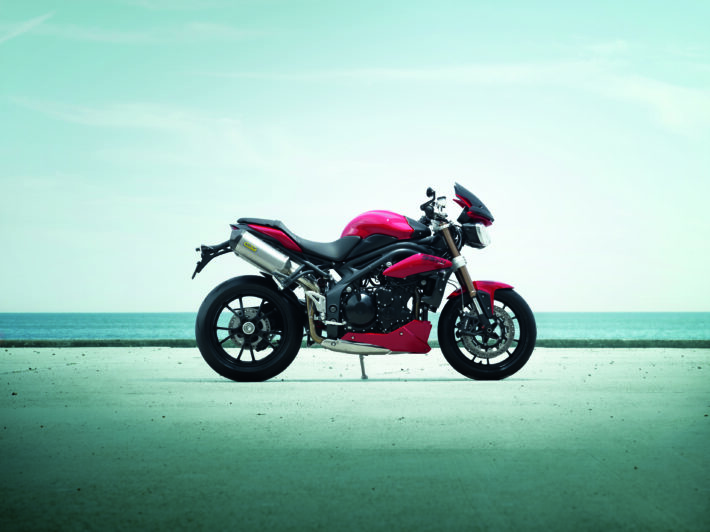
The 21st century saw the firm move up to another level though. The success of the first generation machinery let Bloor invest in R&D, and bikes could now use their own bespoke engine and chassis designs. That started with the T595 Daytona, with its superbike engine and aluminium frame with single-sided swingarm, and continued with the Tiger 955, Sprint ST and Speed Triple T509. There was a short-lived dalliance with four cylinders again, with the Speed Four, TT and Daytona 600 and 650, before Hinckley went back to triples.
Then, the designers added a couple of twin cylinder motors for an all-new classic range: the 790cc Bonneville range and the second-generation heavyweight Thunderbird with its 1600 parallel twin. Now, Triumph is at the top of the European bike-making pile, with its range of adventure bikes, modern retro classics and beefy muscle bikes winning plaudits and awards from owners and critics alike.
Here’s our pick of the best Triumphs from the last twenty years or so – let us know if you agree (or disagree!)
Daytona 650
The mid-2000s were like the Wild West for the 600cc supersports class. The Japanese firms were slugging it out with total model updates every two years, and Honda’s CBR600RR, the Yamaha YZF-R6, Kawasaki ZX-6R and Suzuki GSX-R600 were all incredibly well-sorted machines, with tech that could just about match the flagship superbikes.
So, when Triumph announced it was entering the sector in 2000, with the all-new TT600, the whole biking world was intrigued. Would Hinckley be able to match the best from the east? Well, ‘no’ was the short answer, though the British firm came very close. The TT handled well, and made decent peak power, but the fuel injection and engine tuning was badly flawed on the first version, with poor throttle response and rideability. Triumph soon sorted those issues, but the flawed first impressions – together with the slightly dodgy styling – had sealed the TT’s fate.
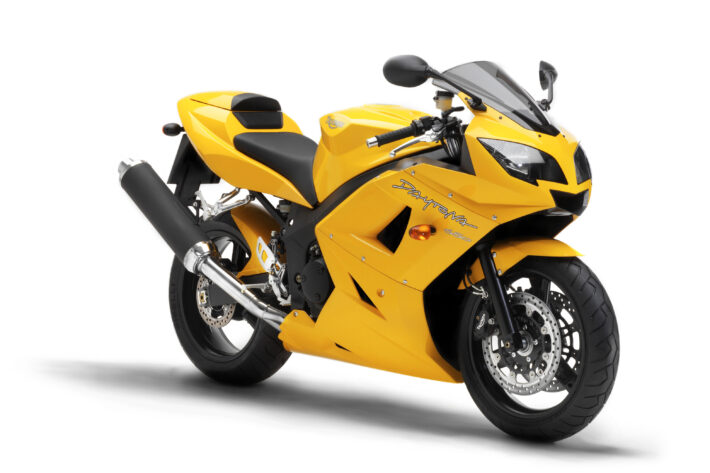
Triumph didn’t give up though, and relaunched the TT a few years later, with sharper, more angular styling, a sorted engine, upgraded chassis, and a new name: the Daytona 600. There had almost been a Daytona 600 before in fact – it was a planned variant of the old TR65 Thunderbird, which was shown off in 1983 but didn’t make it past the prototype stage before the firm closed down.
Finally, Triumph’s supersport machine was on par with the bikes that the TT had failed against. But it was now a couple of years behind, and the all-new 2003 Japanese 600s had moved on again. The ‘03 Daytona was a solid contender, and wasn’t far behind in terms of power, technology or handling. It weighed just 165kg dry and made a claimed 110bhp – but behind the scenes, Triumph was already giving up on its middleweight four-cylinder. The Daytona 675 was on the drawing board at the Hinckley R&D department, but wouldn’t be read for another couple of years.
So Triumph pulled a fast one, bumping up the Daytona 600’s capacity for the final year of production, with a longer-stroke motor giving an extra 47cc, which was just enough to put it back in contention. Like the Kawasaki ZX-636R released a year earlier, the bigger motor gave a healthy torque boost, making it feel a little like a beefy 750 rather than a revvy 600. Added to the solid chassis, unconventional styling and British manufacture, the Daytona 650 was a properly sorted middleweight supersports machine, and looked like it would go on for years of sales success.
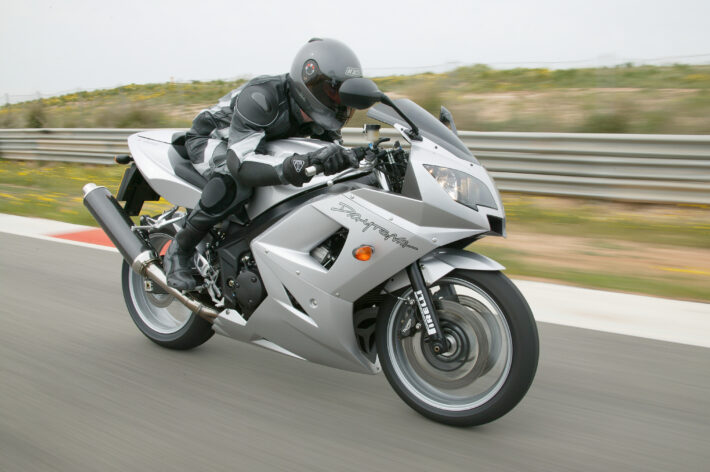
Sadly, or luckily, depending how you look at it, the Hinckley bosses had already consigned their last four-cylinder engine to the scrapheap. The 650 was only built for two years, before being replaced by the much better 675 Daytona, with an all-new three-cylinder motor and brilliant chassis.
Daytona 675
The 600 supersport race class was an exciting place to be in the late 1990s and early 2000s. There were two options: either you had a massively revvy inline-four cylinder 599cc four-stroke from Japan (or Hinckley), or you went for an expensive, occasionally unreliable Ducati 748 or 749 supersports twin, with its exotic chassis and high-maintenance desmodromic motor. In theory, there was a third option, buried in the race regs somewhere, for a middle way: a three cylinder engine with capacity split between the 600cc fours and 750cc twin limits. Who would build such a thing?
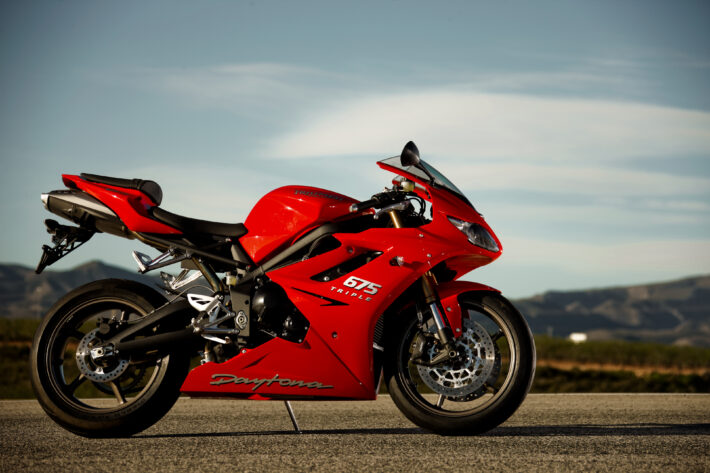
Triumph was, of course, the answer. By now it had established the three-cylinder layout as its trademark powerplant, despite having a few twin-cylinder models and the doomed 599cc fours. Making a 675cc supersport triple had the potential to give the best of both worlds: more peak power than a twin, together with more midrange grunt than a four. Get it right, and it could cut right through the middle in terms of weight and compactness, while being cheaper to build than a twin.
And get it right the Triumph engineers did. The Daytona 675 essentially matched the fours in terms of peak power – putting out a claimed 123bhp – and was right on the mark weight-wise too, at 165kg dry. It had a slick chassis setup, with an aluminium twin spar frame, braced dual-sided rear swingarm, bolt-on subframe and full fairing. The suspension was decent if not spectacular: 41mm USD forks and rear monoshock by Kayaba, with full adjustment. Standard supersports tyre sizes allowed super-sticky rubber, while the brakes were four-piston radial-mount Nissins up front with 308mm discs. It looked amazing too, dropping the questionable styling of the previous TT600 and Daytona 600/650, for a gorgeous, sleek look that rivalled the likes of Ducati (indeed it was much prettier than the contemporary 749).
On the road, the 675 Daytona was comfy for its size, and the larger-capacity three-cylinder motor was a treat. It barked like a little race car when you cracked open the throttle, and progress was more relaxed, with no frantic gear changes to keep the revs up in the stratosphere. Handling was sharp and assured, and the stock suspension and brakes were easily a match for the best in the class.
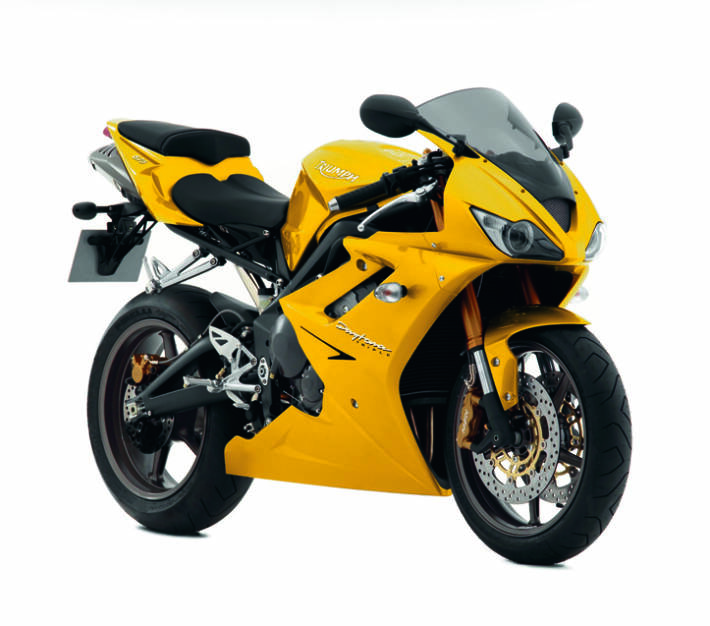
On track, the good news continued. That narrower motor helped ground clearance, and the extra grunt properly hurled you out of slower bends. It hasn’t quite swept the board in racing, though it’s taken four British Supersport titles and a couple of Junior TT wins over the years. That’s probably as much a sign of the levels of factory support available to teams running Japanese brands as anything else mind.
The 675 Daytona was discontinued by Triumph in 2018 when the final 675R model ended production. Triumph reckoned the demand for supersport bikes was in terminal decline, and didn’t want to spend the cash on a new engine to comply with tougher Euro emissions regs coming in. Ironically, the firm did produce a new 765 engine for the naked Street Triple in 2018 – and went on to supply the engine as the control motor for the Moto2 race series. A Daytona 765 seemed inevitable – and there was even a limited production run of a Moto2 replica 765 Daytona in 2019. But as we head towards 2023, there’s no sign of a new supersports Daytona triple for the road any time soon…
Street Triple
The Street Triple was an obvious bike for Triumph to build in 2007. The firm had just released its new Daytona 675 triple, replacing the four-cylinder Daytona 650, and was ending production of the inline four motors altogether. The existing Speed Four middleweight roadster was on its way out, and a new naked 675 triple looked like a no-brainer.
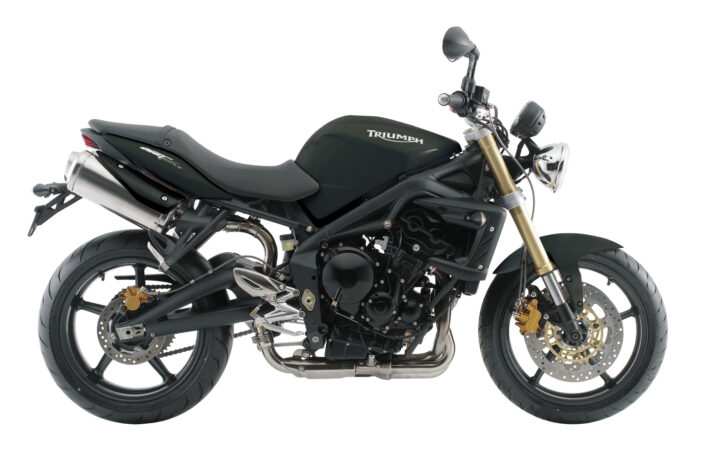
Even so, the new Street Triple impressed massively when it landed. At first glance it looked just like a slightly squashed Speed Triple, with the same twin round headlamps, three-cylinder motor, underseat exhausts and aluminium frame. But the game was given away when you spotted the dual-sided rear swingarm and low-spec twin-piston front brake calipers.
The Street Triple kept fairly closely on the Daytona spec, but had lost around 18bhp from a midrange-boosting engine retune, and came with cheaper, less-fancy running gear. The forks and rear shock didn’t have the same adjustability and the brakes were more basic, as mentioned – but it kept the same aluminium frame spec and supersport tyre sizes.
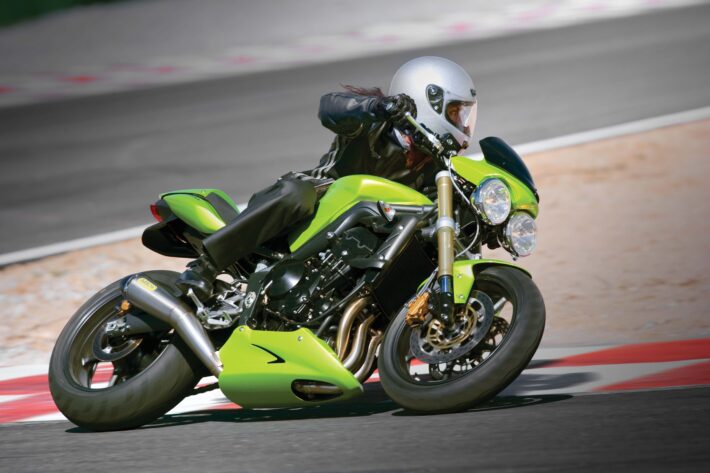
None of this mattered a hoot once you jumped on board though. The Striple (as it became known) was a total blast to ride, from start to finish. Both the engine and chassis changes were perfect for the new bike: it was nimble, grunty, easy to ride and, best of all, loads of fun. The weight was kept low at 167kg dry, and the retuned engine was properly grunty low-down. Those two factors, combined with the upright riding position and wide bars, meant the new mini-streetfighter had proper attitude on the road.
If you wanted to go for it on a twisty back road, or even practice some stunts on private land, it was more than capable. Indeed, it was one of the easiest bikes to wheelie, perfect for beginner stunters to learn on. It would perform well on a race track too, with much of the performance of the pricier Daytona, especially if you swapped in some stickier tyres. But the Street Triple was a joy to ride slowly as well. It was friendly enough to make a great first big bike for post-test novices, and easy as hell to potter around on.
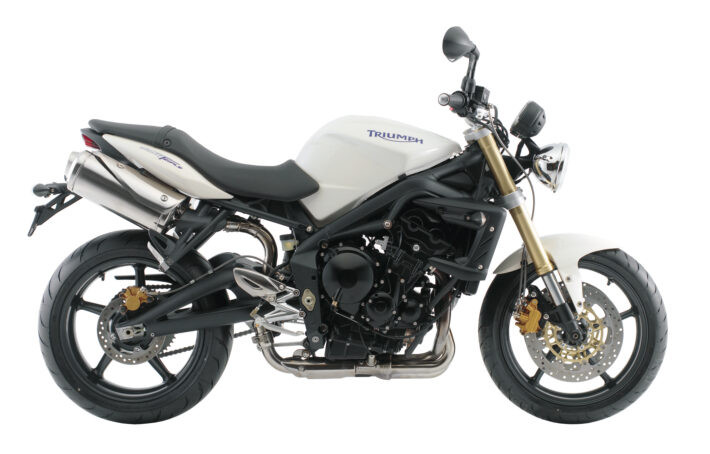
Over the years, the Street has had a few big upgrades, modernising the styling with more angular lights and sharper bodywork, while uprating the chassis parts with ‘R’ variants that boasted fully-adjustable suspension and sharper brakes. The big change came in 2018 though, when the 675 motor was replaced by a new 765 engine, which would go on to be used in Moto2 racing.
Triumph offered three versions: the flagship ‘RS’ with Öhlins and Brembo chassis kit and a full-power 125bhp motor, the ‘R’ with a little less power and Showa shock, and an entry-level ‘S’ model with another power cut, basic electronics and two-piston brakes. Triumph also brought out a 660 motor later on, for the A2-friendly Street Triple 660, with 94bhp when unrestricted, and the statutory 47bhp when restricted for A2 riders.
955i Daytona
Triumph was doing solid work in the mid-1990s – its bikes were decent contenders, and selling well. But in late 1996, it took a massive, audacious step forward when it launched the T595 Daytona. A full-bore 955cc superbike, it was aimed at the very best flagship machinery from Japan – the likes of Honda’s CBR900RR FireBlade, the Kawasaki ZX-9R and Yamaha’s Thunderace. Triumph had redesigned its existing 885cc three-cylinder motor for more power, taking it out to 955cc via a 3mm bigger bore, with some consultancy help from Lotus.
It was a pretty high-tech design, used then-novel fuel injection from French firm SAGEM, had big valves, magnesium covers, four-valves per cylinder, lightweight crank, all of which helped it make a pretty impressive (for the time) 130bhp. That matched the FireBlade, but the slightly chunky-looking Triumph was a bit heavier, tipping the scales at 193kg dry, compared with 183kg for the Blade.
This new high-performance motor was bolted into an equally high performance chassis, based on the firm’s first aluminium perimeter type frame, fabricated from polished oval tubing. The firm added a single-sided rear swingarm for even more trick style, and the Showa suspension was fully adjustable, with 45mm RWU forks and rear monoshock. Brakes were Triumph-branded four-piston front calipers, with massive 320mm discs, and even the fuel tank was innovative, made from lightweight plastic rather than dull steel.
The result was an impressive, fast road bike, with sharp brakes, firm suspension and a strong motor. It wasn’t perfect: the gearbox was a bit ropey, the dashboard minimalist, and the riding position very committed. Commuting and long distances were for the determined, and in summer, the engine heat was a chore. That was how late 1990s superbikes were though, and if you wanted something easier, Triumph would sell you a Sprint ST from 1998 on, with similar performance, in a sporty touring package.
Things went well at first for the T595 – it was critically acclaimed by the press, and initial sales were good. But in the first year, it was hit by a couple of design and manufacture flaws, leading to cracks in the aluminium frame and problems with the gearbox. Triumph worked hard to resolve the issues though, and a revamped model appeared a couple of years later, with a new name – the Daytona 955i. The teething problems were ironed out, and performance was improved, with better ground clearance.
Sadly for Triumph, its superbike was running to catch up almost as soon as it appeared. Yamaha’s YZF-R1 overturned the entire class in 1998, followed by ever-sharper FireBlades, a new GSX-R1000 from Suzuki and Kawasaki’s ZX-10R a few years later. Hinckley responded in 2001 with a redesigned 955i that had a lighter dual-sided swingarm and an extra 17bhp from the engine – but it was way off the Japanese machinery by then.
Cosmetic tweaks continued until the 955i was dropped in 2007, by which point it was drifting into irrelevance against the likes of the Suzuki GSX-R1000, and merely inhabiting a tiny niche as a softer-edged superbike for fans of the British brand. Triumph was perhaps a bit ahead of the pack in dumping its sportsbike range – but it’s stuck to its guns and hasn’t bothered with the unlimited superbike class since.
Sprint ST
The first Triumph Sprint was the Trident Sprint 900: a half-faired version of the Trident sporty roadster, launched in 1992 using the first generation 885cc motor and steel spine-type frame. But it was this 1999 version which really gave the Hinckley firm a solid sport-touring option that could go toe-to-toe with the best in class. That meant the Honda VFR800 launched a year earlier, and the Sprint ST would spend the next decade and a half dicing with the superb Honda.
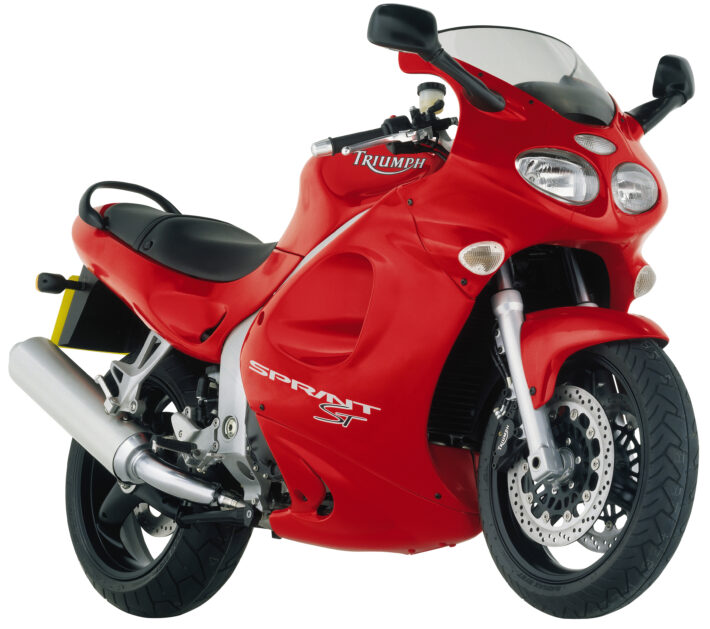
The first ST used some of the technology developed for the T595 superbike, including the 955cc triple engine and single-sided swingarm, but it had its own cheaper extruded twin spar aluminium frame, rather than the complex fabricated oval tube frame on the T595. Dubbed the T695, the ST had a retuned variant of the 955cc engine that made 108bhp rather than the 130bhp of the T595, and the Sprint weighed in at a chunky 210kg dry. Those numbers were a fair match for the Honda VFR – Triumph had learned early on that you had to effectively benchmark the competition, and match if as best you could, if you were going to succeed against the Japanese.
The riding position was much more upright than the T595, with a massive comfy dual seat and lots of space for a pillion too. The full fairing gave good wind and weather protection, and optional hard luggage added massively to the practicality of the Sprint.
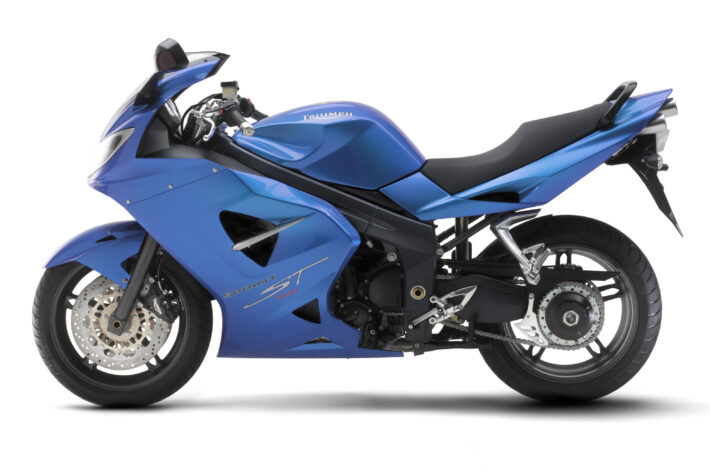
Triumph was able to match – or even beat – the sporty potential of the VFR as well. The three-cylinder engine was grunty and characterful, even compared with the evocative Honda V-four, and the bike handled very well indeed – it could rival some supposed sports bikes if you swapped the standard sport touring tyres for something more sticky.
The Sprint was updated in 2002 for a bit more power, before it moved to the same 1050 motor as the Speed Triple 1050 and Tiger 1050 in 2005. The motor got a longer stroke to boost the capacity, and made for an even stronger lump, with bags of torque all through the midrange. It had a series of chassis and styling tweaks, including underseat exhausts and shorter wheelbase, and optional ABS appeared the following year.
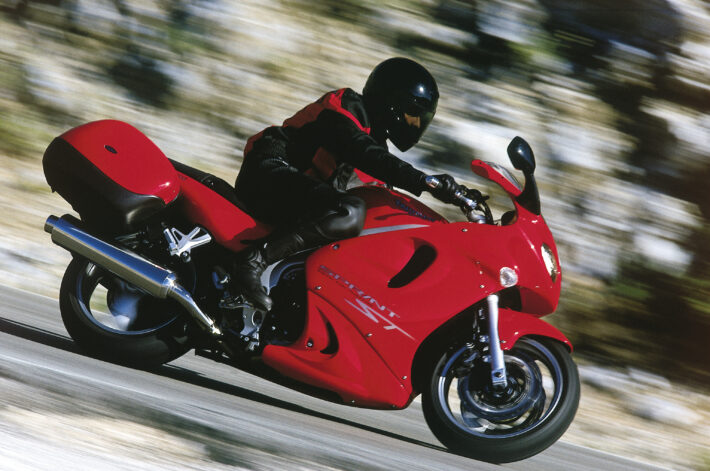
The final variant of the Sprint was the GT, released in 2010 and sold until 2017. It made even more power, up to 128bhp, but was given a much more touring overhaul, with bigger fairing, longer wheelbase, more space for rider and pillion and a side-mounted exhaust. It had lost some of the sporty potential of the original, but by then the sport-touring market was diminishing in favour of adventure machinery. By 2017, tightening emissions regs ruled the 1050 motor out, and Triumph didn’t fancy spending the R&D cash needed for a new Sprint, favouring the new Tiger range of adventure tourers instead.
Speed Triple
If we were only picking a top three of great modern Triumph bikes, this would still make the list for sure. The Speed Triple goes back almost to the very start of the Hinckley Triumph project, and is still one of the firm’s top performers even now, with an instantly recognisable style and character all of its own.
The earliest Speed Triple was part of the first generation modular range, initially sold as a 900 from 1994-on, with a short-lived 750 version appearing for a year in 1996. The 900 was a simple redesign of the successful Daytona 900 sportsbike, with the full fairing removed, wide handlebars, a single round headlamp and upright riding position. Its 885cc 12-valve DOHC triple engine made the same 97bhp as the Daytona, in a lighter 209kg package.
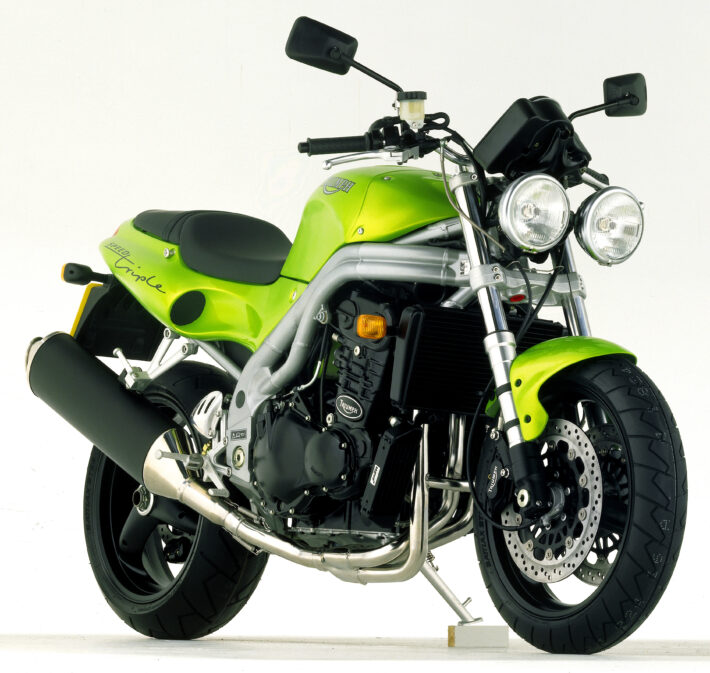
It shared its steel tube spine frame, sporty Kayaba suspension and four-piston brakes with the sportsbike, but the so-called ‘factory streetfighter’ redesign made for a very different, more aggressive machine, which made a great urban warrior and backroad blaster…
The cult appeal of the Speed Triple really took off in 1997 though, with the release of the T509 version. This had a weird mix of old and new tech; the engine was the same old 885cc triple as on the 900, but with SAGEM fuel injection as on the T595 superbike. The chassis package was also based on the T595, with similar aluminium tube frame, single-sided swingarm and 45mm forks, but with a radical streetfighter overhaul. An enormous 190-section rear tyre gave an incredibly aggressive rear end, while up front, those twin round headlights appeared for the first time, setting the design trend for the next decade of Speed Triple production.
Triumph soon upgraded the motor for 1999, giving it the full 955cc capacity in retuned form, making 108bhp with a really grunty delivery. Dry weight was around 195kg, giving a solid power-to-weight ratio for the turn of the century. There were various engine and chassis tweaks over the next five years, all sharpening up Triumph’s street fighting thug, before 2005 saw the same 1050 engine upgrade as seen on the Sprint ST sport tourer and Tiger adventure bike. Power was up to 130bhp and weight down to 189kg dry, the chassis made a great job of handling it all, and the Speed Triple was right at the top of the full-bore naked streetfighting class.
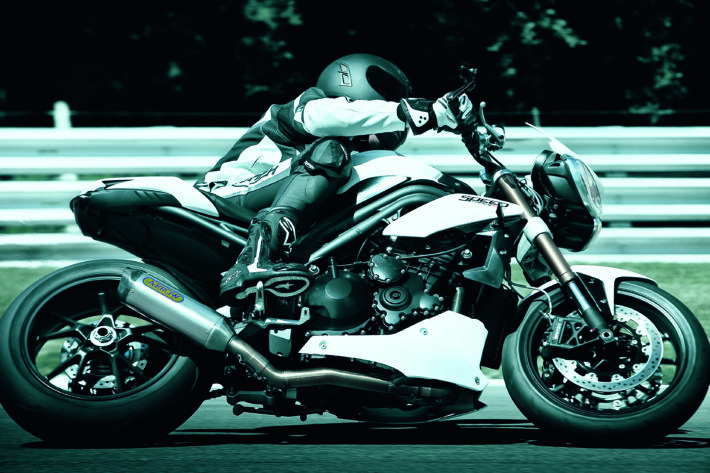
2010 brought another major update, with a revised chassis setup aimed at modernising the handling by putting more weight over the front end. The motor was fettled for more grunt, but stayed at the same 1,050cc capacity and 130bhp peak power, while the overall weight dropped by another few kilos. The biggest visible change was to the headlights though: the old round lights finally replaced by more angular bug-eye lighting units.
The latest Speed Triple is the 1200 version, launched in 2021 with an all-new 1,160cc engine. Ride-by-wire throttle, cutting edge electronics, a sub-200kg wet weight and super high-end Brembo Stylema brakes and Öhlins suspension makes for an amazing package. Want all that with a small retro-look half fairing? Check out the Speed Triple 1200 RR, released in 2022, which gives the venerable Hinckley fighter a totally new look…
Bonneville
Ask a non-biker of a certain age about Triumph, and they’ll generally mention the Bonneville. It started off as a 650cc parallel twin in the late 1950s, growing into a 750 in the 1970s, and was the last major model built by the old Triumph Engineering company in the 1980s.
When John Bloor revived the brand, it seemed like an obvious model to bring back in modern form. But it wasn’t until 2001 that the new Bonneville appeared, this time a much more modern 790cc parallel twin, with DOHC and four valves per cylinder. It stayed with air cooling and carburettors though, and the output was fairly leisurely: just 62bhp, driving through a five-speed gearbox. A traditional steel tube cradle frame and standard twin-shock rear suspension, together with a 19 inch front wheel, gave the look of the original Bonneville.
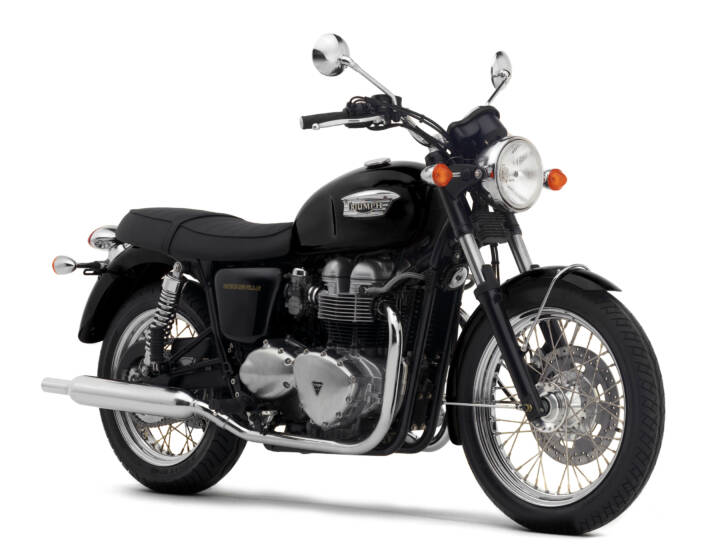
The rest of the 2000s saw gradual evolution of the Bonnie: the style remained much the same, but the engine grew in size to 865cc, and gained fuel injection then water-cooling, in order to keep up with tightening emissions regs while giving modest power and torque improvements. From 2017, the engine grew to 900cc in the base T100 version, while a larger 1200 twin cylinder motor powered the T120 variant, making 72bhp in a so-called ‘high-torque’ tune and 105bhp in full-power versions. The latest bikes boast advanced electronic kit, including ABS and traction control, rider power modes, trip computer, LED lighting and more.
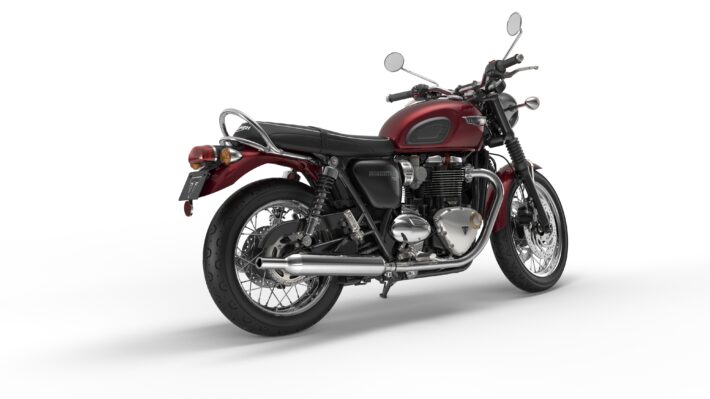
The basic Bonneville roadster, in the various 790, 865, 900 and 1200 capacities, has formed the foundation for a slew of variants, from the US-styled Speedmaster and Bonneville America and the Scrambler models, to the Thruxton café racer, Bobber and Speed Twin. Race-spec suspension and brakes, high-level exhausts, cruiser riding positions, and all manner of different styling gives Triumph a massive range of modern classics, from the same basic foundation of parallel twin engines and steel tube frame setups.
Rocket 3
It’s the most audacious bike Triumph has ever built – indeed, it has a claim to be one of the most audacious production motorcycles made by any bike firm. A 2.3 litre engine is big for a car, it’s even a bit big for a large van. And putting one in a motorbike sounded like an April fool when the rumours of its existence started leaking out in spring 2004.
But that’s exactly what Triumph had built. A 2,294cc triple, arranged with the cylinders running fore-and-aft rather than across the frame, a near 150bhp power output, 145ft lb of torque and shaft final drive, all bolted into a huge power-cruiser chassis. It weighed an awful lot – 320kg dry – but handled this mass with some aplomb. It immediately became the best ultra-power cruiser, knocking the likes of Honda’s Valkyrie and Harley-Davidson’s V-Rod for six.
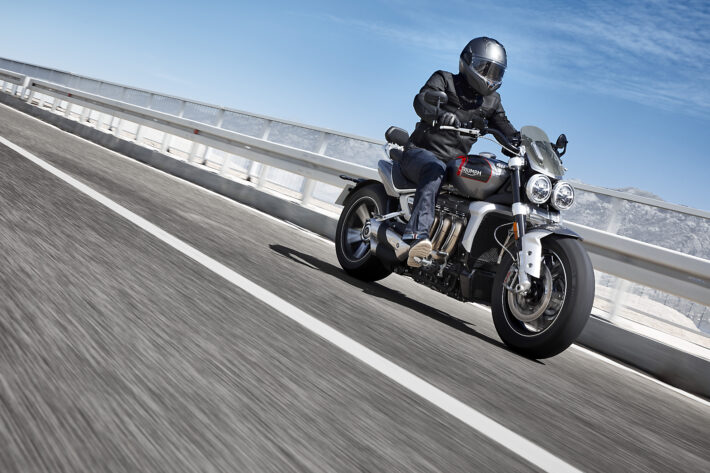
It was superb as a lazy cruiser of course, trundling along a sunny sea front or the like – but it could also hustle down a twisty road far quicker than you’d imagine. The brakes did well considering the mass, there’s a fair amount of ground clearance for a cruiser, and once you adapt to the weight and steering geometry, it’s a proper hoot to chase down poorly-ridden sportsbikes…
The sheer size sometimes catches you out in urban riding – spaces which most other bikes would sail through aren’t an option on the Rocket, as much from its sheer length as width. And you’ll need a very good technique to pick one up on your own if you drop it…
The original Rocket III was an enormous hit, and continued on sale for a decade and a half with only minor updates. Triumph released three more versions: the Roadster was a bit sharper with normal foot rest positions rather than forward controls, the Classic had the American custom styling, and the Touring added panniers and a windshield to the mix for better long-distance performance. All stuck with the same basic engine and chassis layout.
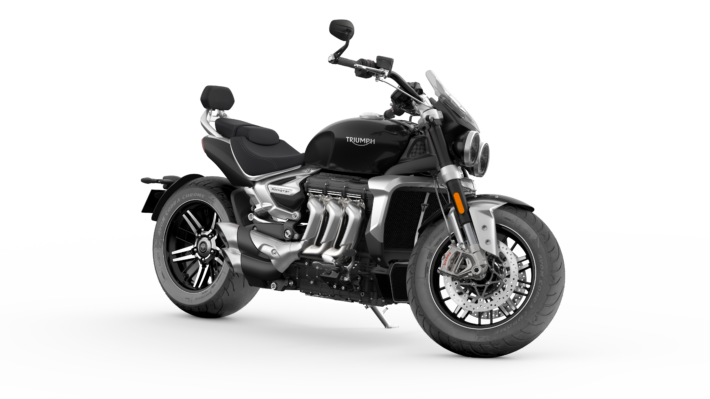
By 2019 though, the Rocket III was getting a bit long in the tooth, and Triumph brought out a brand new version, the 2.5 litre Rocket 3. It had an even bigger motor: now up to 2,458cc, an aluminium frame, state of the art electronics, Brembo brakes and a proper modern styling upgrade. Power went up to 165bhp and weight dropped to 291kg dry – but the basic nature of the Rocket remains. And it’s still one of the most audacious motorcycles you can buy…
Tiger 800
Triumph’s modern Tiger range was some way ahead of the curve: the original 885cc dual sport machine was doing adventure touring back in 1992 when it was an obscure nice pursuit. And it did very well for the next couple of decades, thanks to sensible upgrades and a neat road-biased design.
By 2010 though the sector had moved on. The adventure bike class was going crazy, with bikes like the BMW R1200 GS selling by the truckload al across Europe. And people wanted more hardcore machinery – both in terms of styling, and offroad ability. Triumph needed to give its Tiger a bit of a tweak.
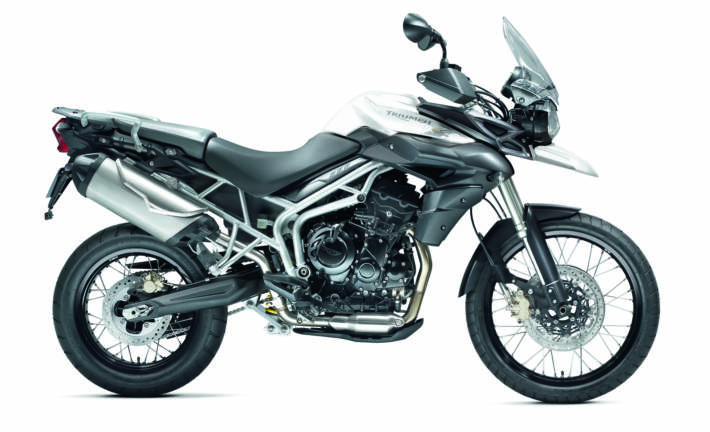
And it did a proper job, launching an all-new 800 Tiger at the end of 2010, followed by a 1200 version a year later. The 800 came with a 799cc triple engine, produced by giving the excellent 675 Daytona lump a longer stroke, up to 61.9mm from 52.3mm, while keeping the same 74mm bore, 12-valve head, DOHC and fuel injection. Compression was reduced and valve timing tweaked, giving a 95bhp peak power output, and a much torquier delivery, especially down low and in the midrange.
The new 799cc motor lived in a proper steel tube trellis frame, tough enough for fairly hardcore offroad use, and with the option for some solid offroad-capable running gear: wire spoked wheels and longer-travel suspension on the XC variant, and cast rims on the standard 800. Those two versions gave buyers the option of a more off-road capable machine, or a more Tarmac-biased tourer.
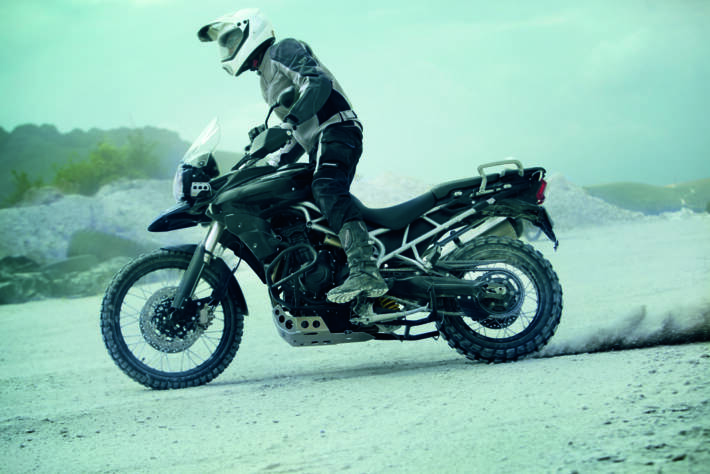
There was a lot of praise for the first 800: the engine was a peach, and a fantastic evolution of the 675 lump, with great performance for the adventure bike role. There was enough kit and optional accessories to take on BMW’s F800 GS, the styling was sharp and on point, and Hinckley’s build quality was well up at the top of the class. In the right hands, and with proper dirt tyres, it made a solid middleweight offroad machine, but was also a pleasure to ride on the road. It was nimble and sporty enough to have a ball on twisty back roads, yet also spacious and comfy enough for long motorway runs.
Triumph updated the Tiger 800 in 2015 and 2018, adding more electronic riding aids, and eventually splitting the range into six different bikes: dirt-focused XC models and XR versions aimed at road work. Those models were further split – basic XCX and XCA with WP suspension, and the base XR, an XRX, low-seat XRX and XRT touring variant. It sounds more complex than it is, honest…
The Tiger 800 was replaced by a new Tiger 900 in 2020, with a new 888cc engine, uprated chassis and electronics, lighter 192kg mass and new styling. It comes in GT road and Rally dirt versions, with Pro variants of both adding more kit and performance.
Tiger 1200
Triumph had a solid dual-sport or adventure touring range back in 2011. The new Tiger 800 looked like a proper modern ADV machine, while the elderly Tiger 1050 had classy styling, a great engine and excellent road manners.
But if Hinckley was serious about taking on the BMW R1200 GS, it needed something more. It needed a full 1200 motor, putting out at least 120bhp and loads of grunt. It probably needed shaft drive. It really needed some plausible off-road ability. And it also needed to look hard as nails, packed with high-tech, and ready to ride to Mongolia at the drop of a hat.
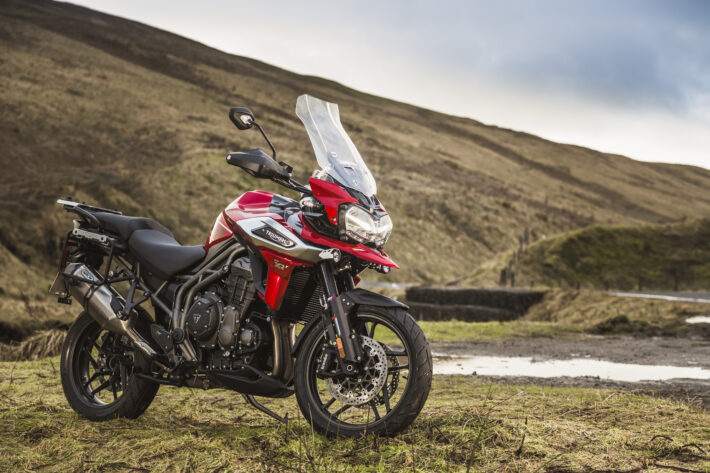
The answer was the Tiger 1200 Explorer, first seen late 2011. It ticked all those boxes: Triumph’s first ever shaft drive, a giant new 1,215cc three-cylinder engine with 12-valve heads, fuel injection, and a 135bhp power output. It had a single-sided swingarm, steel tube trellis frame, chunky, long-travel suspension and a 20-litre fuel tank. It had 25bhp more than an R1200 GS Adventure – but was also a few kilos heavier ready-to-ride.
On the road, the big Tiger was imperious. The engine was super-strong (as a 1200cc+ triple could hardly fail to be of course…), the chassis stable and composed, there was plenty of wind and weather protection, and the riding position comfy enough for a full day of touring miles. The fuel consumption wasn’t great though, and the 20 litre tank meant a sub-200 mile range if you were pushing on.
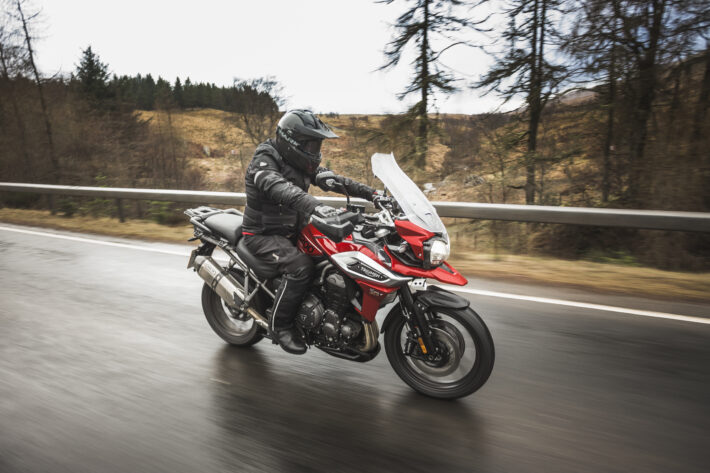
Triumph used the same range extension as on the 800 Tiger, splitting the 1200 into an XC offroad bike and XR touring model, with further spec variations available: XRT, XCX, XCA, all offering different mixes of equipment and accessories. By 2018, at the top end, you could spec a genuine luxury touring setup, with heated grips and seat, TFT colour LCD dash, keyless ignition, electric windscreen, hard luggage and all the rest. Advanced kit like a quickshifter, cruise control, cornering ABS/traction control/headlights, WP suspension and Brembo brakes were all available too.
The 1200 Tiger had probably gone as far as it could go by 2021 – all the add-on tech in the world couldn’t disguise the big, heavy motor and basic chassis. So for 2022, we got an all-new flagship Tiger 1200, with a new 148bhp 1,160cc triple engine, 25kg weight loss, even more technology, and a slimmer, sleeker chassis profile.
5 comments on “Top 10 Triumph Motorcycles”
Excellent article ! Thankyou !
Very good description on the bikes , I am looking of upgrading to a triumph 800 to 1200 tiger
Very helpful
I bought a Sprint ST in December 2005 and have done 58,000 miles on it and am still very happy with it and ride it regularly, at the age of 82. I agree whole heartedly with you top 10 selection
You’ve overlooked the 1050 Tigers, a really good long distance runner
Tiger 1050 sport! The ultimate road-focused tiger, better than the 955i (which I owned) and the 800 (which I tested), Brilliant bike!!